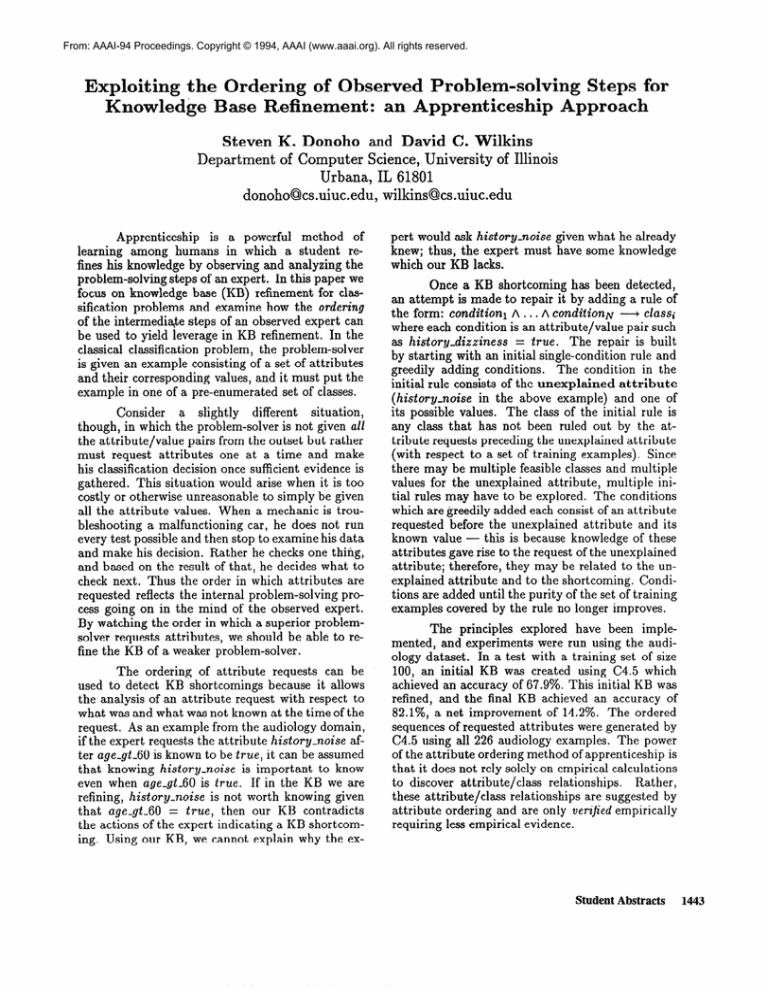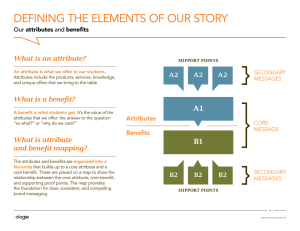
From: AAAI-94 Proceedings. Copyright © 1994, AAAI (www.aaai.org). All rights reserved.
Exploiting the Ordering of Observed Problem-solving Steps for
Knowledge Base Refinement: an Apprenticeship Approae
Steven K. Donoho and David C. Wilkins
Department
of Computer Science, University of Illinois
Urbana, IL 61801
donoho@cs.uiuc.edu,
wilkins@cs.uiuc.edu
Apprenticeship
is a powerful method of
learning among humans in which a student refines his knowledge by observing and analyzing the
problem-solving steps of an expert. In this paper we
focus on knowledge base (KB) refinement for classification problems and examine how the ordering
of the intermediate steps of an observed expert can
be used to yield leverage in KB refinement. In the
classical classification problem, the problem-solver
is given an example consisting of a set of attributes
and their corresponding values, and it must put the
example in one of a pre-enumerated set of classes.
Consider
a slightly
different
situation,
though, in which the problem-solver is not given all
the attribute/value pairs from the outset but rather
must request attributes one at a time and make
his classification decision once sufficient evidence is
gathered. This situation would arise when it is too
costly or otherwise unreasonable to simply be given
all the attribute values. When a mechanic is troubleshooting a malfunctioning car, he does not run
every test possible and then stop to examine his data
and make his decision. Rather he checks one thing,
and based on the result of that, he decides what to
check next. Thus the order in which attributes are
requested reflects the internal problem-solving process going on in the mind of the observed expert.
By watching the order in which a superior problemsolver requests attributes, we should be able to refine the KB of a weaker problem-solver.
The ordering of attribute requests can be
used to detect KB shortcomings because it allows
the analysis of an attribute request with respect to
what was and what was not known at the time of the
request. As an example from the audiology domain,
afif the expert requests the attribute history-noise
ter age-gt-60 is known to be true, it can be assumed
that knowing history-noise
is important to know
even when age-gt-60 is true. If in the KB we are
refining, history-noise
is not worth knowing given
that age-gt-60
= true, then our KB contradicts
the actions of the expert indicating a KB shortcoming. Using our KB, we cannot explain why the ex-
pert would ask history-noise
given what he already
knew; thus, the expert must have some knowledge
which our KB lacks.
Once a KB shortcoming has been detected,
an attempt is made to repair it by adding a rule of
the form: conditionl A . . . A conditionN _+ classi
where each condition is an attribute/value pair such
as history-dizziness
= true.
The repair is built
by starting with an initial single-condition rule and
greedily adding conditions.
The condition in the
initial rule consists of the unexplained attribute
(history-noise
in the above example) and one of
its possible values. The class of the initial rule is
any class that has not been ruled out by the attribute requests preceding the unexplained attribute
(with respect to a set of training examples). Since
there may be multiple feasible classes and multiple
values for the unexplained attribute, multiple initial rules may have to be explored. The conditions
which are greedily added each consist of an attribute
requested before the unexplained attribute and its
known value - this is because knowledge of these
attributes gave rise to the request of the unexplained
attribute; therefore, they may be related to the unexplained attribute and to the shortcoming. Conditions are added until the purity of the set of training
examples covered by the rule no longer improves.
The principles explored have been implemented, and experiments were run using the audiology dataset. In a test with a training set of size
100, an initial KB was created using C4.5 which
achieved an accuracy of 67.9%. This initial KB was
refined, and the final KB achieved an accuracy of
82.1%, a net improvement of 14.2%. The ordered
sequences of requested attributes were generated by
C4.5 using all 226 audiology examples. The power
of the attribute ordering method of apprenticeship is
that it does not rely solely on empirical calculations
to discover attribute/class relationships.
Rather,
these attribute/class relationships are suggested by
attribute ordering and are only verified empirically
requiring less empirical evidence.
StudentAbstracts
1443






